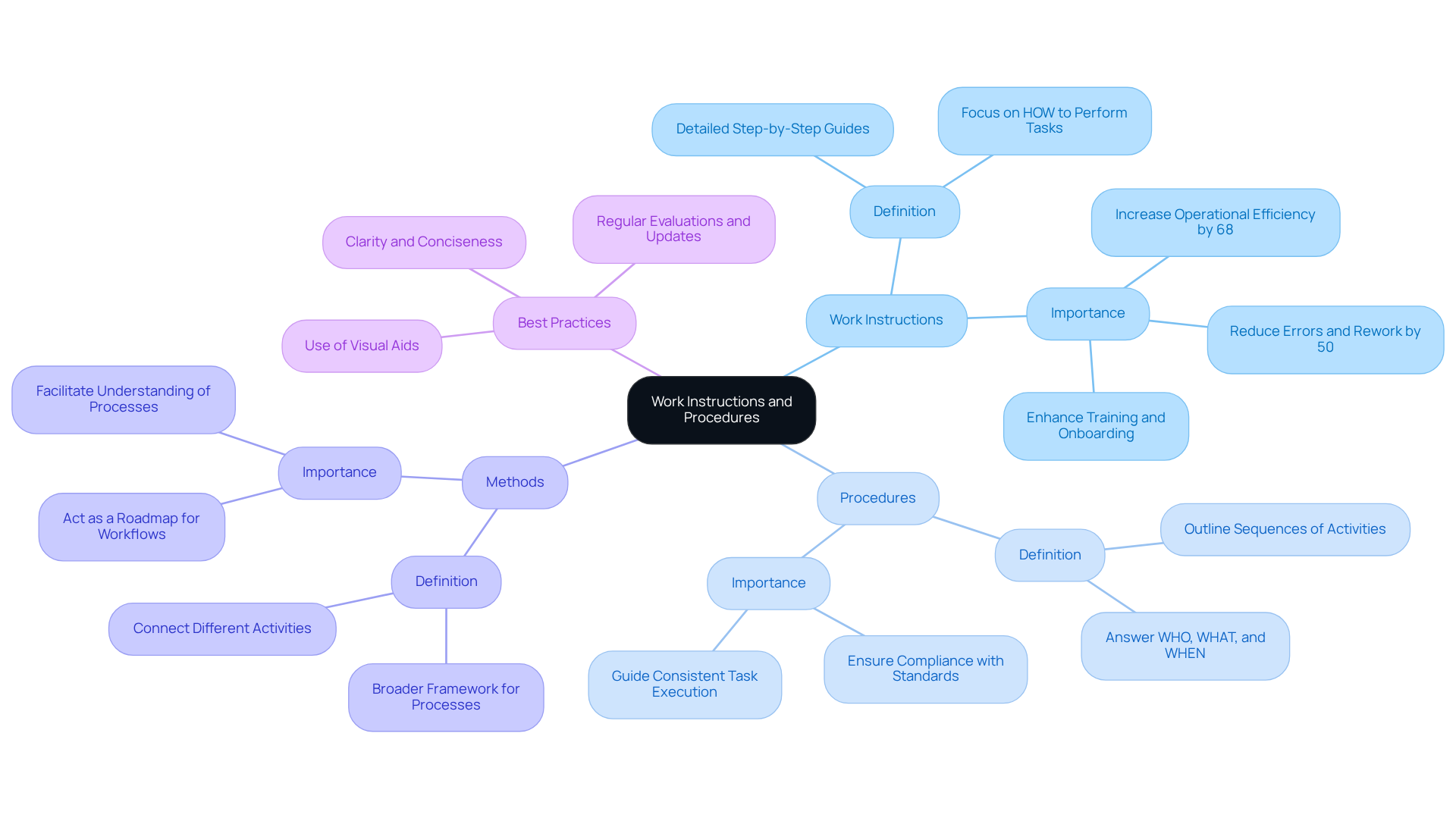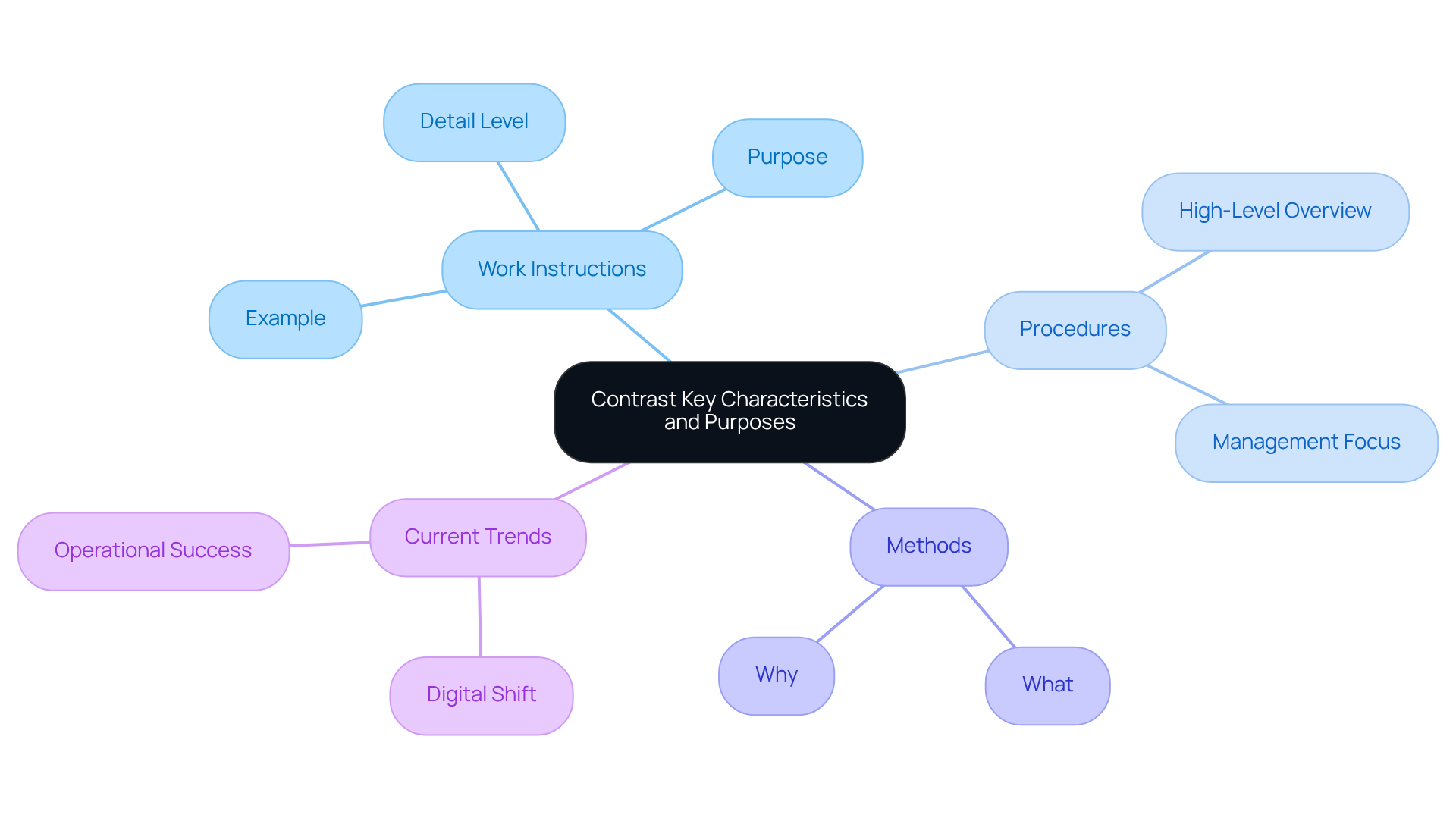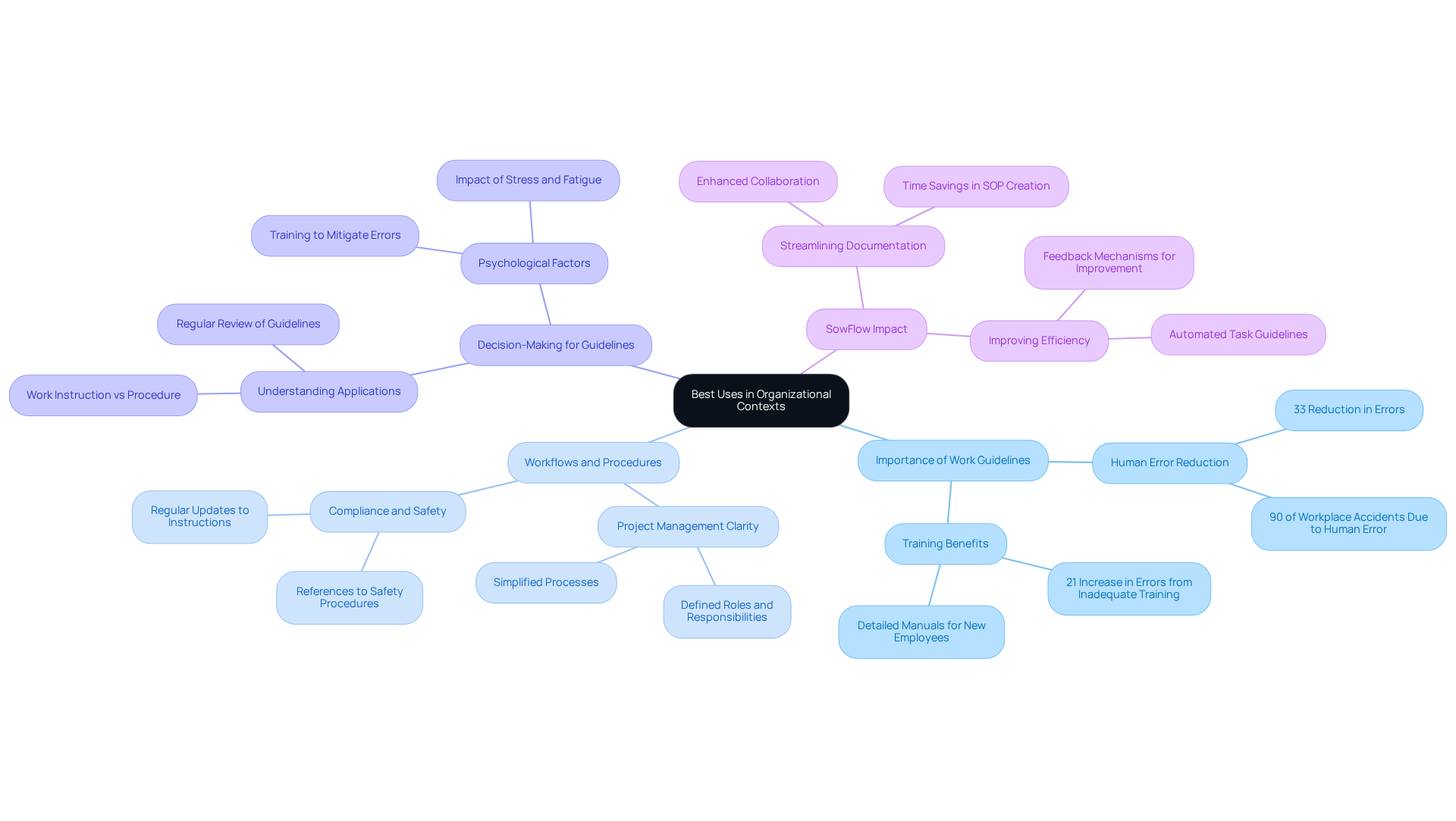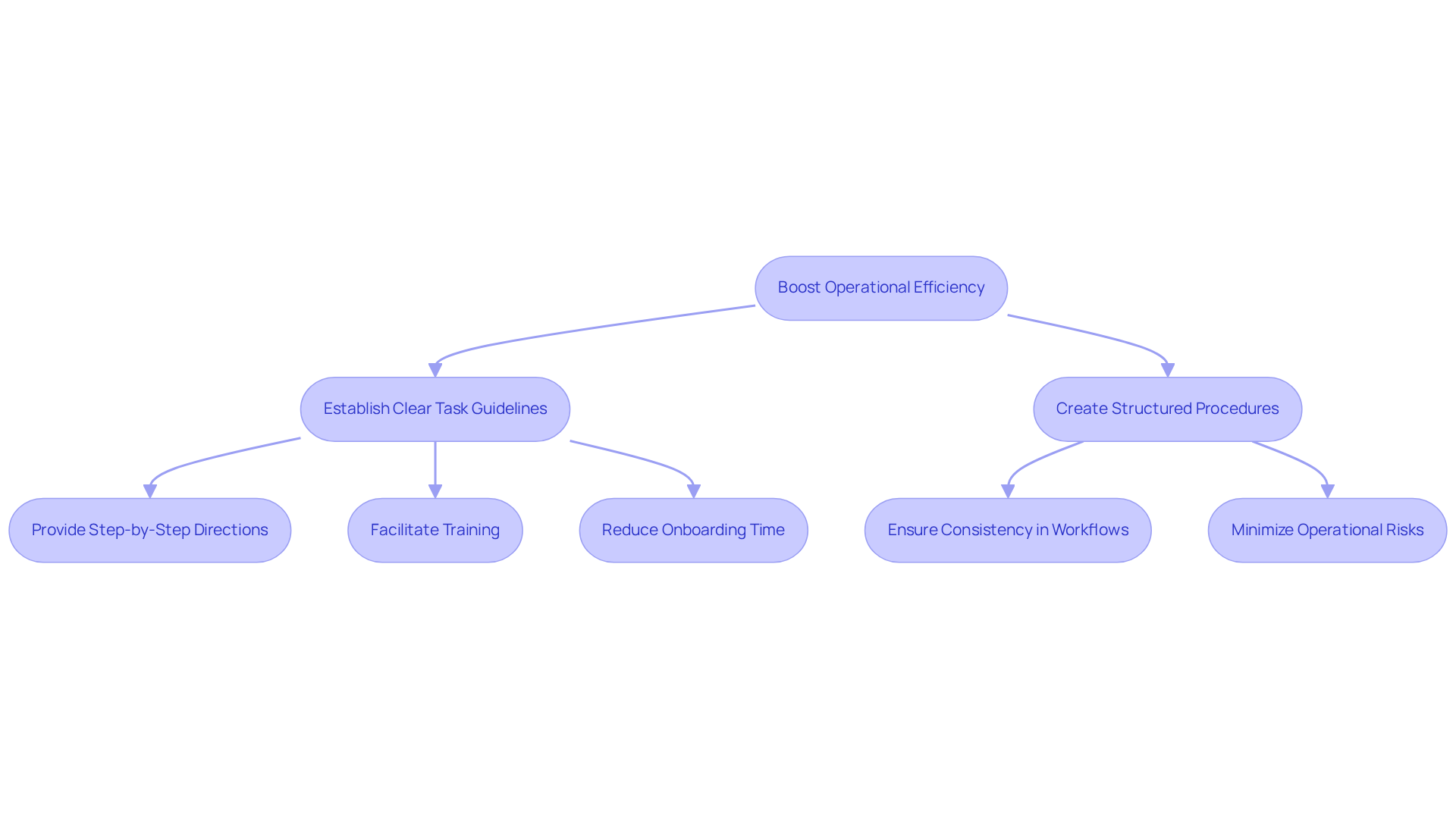
Remote Team Documentation Strategies
|
October 17, 2025
|
Work Instruction vs Procedure: Key Differences for Operations Managers
Overview
You might be wondering what really sets work instructions apart from procedures. Well, the key differences lie in their level of detail and purpose. Work instructions give you specific, step-by-step directions for tasks, while procedures take a broader view, outlining the processes and connections between activities.
It’s interesting to note that organizations with clear work guidelines often see significant improvements in operational efficiency and fewer errors. This just goes to show how crucial clarity and regular updates are in keeping effective documentation.
So, let’s dive into why having these distinctions can make a big difference for you!
Key Highlights:
- Work instructions provide step-by-step directions for specific tasks, ensuring accuracy and consistency.
- Organisations with clear guidelines experience a 68% increase in operational efficiency and a 50% reduction in mistakes.
- Procedures outline the broader framework of processes, connecting various activities and ensuring compliance.
- Effective guidelines should prioritise clarity, conciseness, and visual aids to enhance understanding.
- Regular evaluations and updates of guidelines are essential for maintaining their relevance and effectiveness.
- Work instructions are crucial in high-stakes environments like manufacturing, reducing human error rates by up to 33%.
- Methods help streamline workflows involving multiple steps or departments, improving collaboration and efficiency.
- Digital documentation practises are becoming prevalent, moving away from paper-based methods to enhance accessibility and continuous improvement.
- SowFlow facilitates the creation and management of task guidelines, saving time and improving documentation processes.
- Clear documentation practises foster a culture of operational excellence and support training and onboarding processes.
Introduction
You might be wondering about the differences between work instructions and procedures. Understanding these nuances is super important for operations managers like you who are aiming for efficiency and accuracy in your organization. These documents are crucial in guiding your teams through complex tasks, but their distinct purposes can sometimes create confusion.
As more organizations jump on the digital documentation bandwagon, a big question arises: how can you effectively use these tools to boost operational performance and cut down on errors? By exploring the key differences and best practices for using work instructions and procedures, you can unlock some significant improvements in workflow management and overall productivity.
So, let’s dive into this together!
Define Work Instructions and Procedures
You might be wondering what the distinction is between work instruction vs procedure. Well, they’re those thorough documents that lay out clear, step-by-step directions for carrying out specific tasks. Their main goal? To ensure that everything is done accurately and consistently. And let’s be real—who doesn’t love a little visual aid to help things along? In fact, organizations that have solid guidelines often see a whopping 68% boost in operational efficiency and a 50% drop in mistakes and rework. That really highlights just how vital work instructions are for streamlining operations.
Now, let’s switch gears and talk about methods. These provide a broader framework, outlining the overall steps needed to complete a process. They show how different activities connect and the order in which they should happen, acting like a roadmap for your organizational workflows. While procedures help you grasp the big picture, understanding work instruction vs procedure zooms in on those crucial details that make execution successful.
So, what makes guidelines truly effective? Think clarity, conciseness, and visuals that enhance understanding. The best practices for developing these task guidelines stress the importance of regular evaluations and updates to keep them relevant and precise. With SowFlow's immediate documentation features, organizations can whip up and tweak user guides in no time, ensuring that operational guidelines remain fresh and efficient in our ever-changing business world. By adding visuals and diagrams—and leveraging SowFlow's solutions—organizations can really amp up their operational efficiency. Plus, incorporating Lean Six Sigma principles can further enhance these guidelines by promoting a systematic approach to improving processes. Now, doesn’t that sound like a win-win?

Contrast Key Characteristics and Purposes
You might be wondering what sets work instruction vs procedure apart. Well, the main difference lies in their level of detail and intended purpose. Work guidelines are all about the 'how' of performing activities. They specify actions, safety requirements, and quality checkpoints to ensure everything is done right. For instance, think about onboarding a new employee: a protocol might lay out the overall steps, but a task guideline dives into the nitty-gritty, like filling out forms or setting up accounts. It’s pretty impressive that companies using task guidelines have reported a 68% boost in operational efficiency and a 50% drop in mistakes and rework. Talk about a productivity game changer!
Now, let’s switch gears and talk about methods. These provide a broader perspective, explaining the 'what' and 'why' of a process. They’re more high-level documents aimed at management and supervisors, ensuring everyone’s on the same page and compliant across departments. This distinction shows that while both work instruction vs procedure are crucial for operational documentation, they serve different roles within an organization. Plus, understanding how SOPs relate to work guidelines is key, as SOPs set the overarching framework that guides those work guidelines.
Current trends in documentation practices really highlight the need for clarity and accessibility. More and more organizations are jumping on the digital bandwagon to streamline how they create and manage these documents, moving away from those outdated paper-based methods. This shift not only boosts efficiency but also supports continuous improvement by making information easily available to employees. As operations managers start to see the importance of well-structured documentation, they can use these tools to create a culture of quality and operational excellence. Just look at Boeing’s adoption of Lean Six Sigma principles; it’s a perfect example of how effective documentation can lead to operational success.

Identify Best Uses in Organizational Contexts
You might be wondering why work guidelines are so crucial in places where accuracy and uniformity really matter, like in manufacturing and technical support. Well, they serve as detailed instructions for tasks that, if done incorrectly, could have serious consequences. For instance, in manufacturing, having precise work guidelines can cut human error rates by up to 33%! That’s a big deal when it comes to product quality and safety. Plus, these guidelines are super helpful for training new staff, ensuring they grasp complex tasks and stick to established standards.
Now, when it comes to workflows that involve multiple steps or departments—like project management or compliance activities—methods take the spotlight. They offer a broader framework that helps teams navigate interconnected tasks, making collaboration smoother and keeping everyone compliant with regulations. Just think about it: a clearly defined process can really simplify project management by clarifying roles and responsibilities, which ultimately boosts efficiency.
So, how do operations managers decide when to use work instruction vs procedure? By understanding the right application, they can significantly improve organizational efficiency. Using guidelines for specific tasks can help reduce mistakes, while the distinction between work instruction vs procedure enhances overall workflow management, ensuring all team members are on the same page. Regularly reviewing operational guidelines is also key to keeping them relevant and accurate as the organization evolves. And let’s not forget about the psychological factors that can lead to human error, like stress and fatigue—recognizing these can help operations managers maintain effective documentation.
Speaking of documentation, let’s talk about SowFlow. It’s changed the game for how teams record tasks and serve clients. Anastasia Masadi, a Product Owner, put it perfectly: "I do not have to take each screenshot separately, and do not even have to leave the browser while I am creating SOPs and training materials. SowFlow gave me time from my life back." This really shows how SowFlow empowers teams to whip up SOPs and training materials in no time, transforming the documentation process and saving precious time. By streamlining the creation of task guidelines and processes, SowFlow boosts efficiency and lightens the load for operations managers, allowing them to focus on strategic initiatives.

Evaluate the Impact on Operational Efficiency
You might be wondering how to boost operational efficiency in your organization. Well, establishing clear task guidelines and understanding work instruction vs procedure is key! When you have solid work guidelines in place, training becomes a breeze. It really cuts down the onboarding time and helps reduce mistakes by giving employees straightforward, step-by-step directions on how to perform tasks. For instance, organizations that have rolled out structured task guidelines have seen a noticeable drop in error rates, which means faster onboarding and better overall performance.
Now, let’s dive into procedures. These are all about creating a structured approach to workflows, ensuring that everything runs smoothly and consistently across the board. This kind of documentation doesn’t just help with resource management; it also helps to minimize operational risks. When you consider the differences in work instruction vs procedure, you’re building a solid framework that aligns with your organization’s goals. It’s all about fostering a culture of continuous improvement.
As operations managers often point out, having clear documentation practices not only boosts team performance but also leads to a more efficient and responsive operational environment. So, what documentation challenges are you facing? Let’s chat about how you can tackle them!

Conclusion
You might be wondering about the difference between work instructions and procedures, right? Understanding this distinction is super important for operations managers who want to boost organizational efficiency. Both types of documents are crucial, but they play different roles in guiding workflows. Work instructions give you detailed, step-by-step guidance on specific tasks, ensuring accuracy and consistency. On the other hand, procedures provide a broader view of processes, outlining how everything connects.
The article really shines a light on why these documents matter, especially when it comes to operational efficiency. Companies that have structured work guidelines often see big improvements, like lower error rates and quicker onboarding processes. Plus, using digital tools like SowFlow can make creating and managing these documents a breeze, helping organizations continuously improve.
In the end, effectively using work instructions and procedures helps create a culture of quality and operational excellence. It’s a good idea for operations managers to regularly review and update their guidelines. Keeping them fresh not only ensures they stay relevant but also empowers teams to tackle challenges with confidence. By embracing these best practices, organizations can achieve significant gains in productivity, safety, and overall performance. So, let’s make it a priority to have clear and accessible documentation!
Frequently Asked Questions
What are work instructions and procedures?
Work instructions and procedures are detailed documents that provide clear, step-by-step directions for performing specific tasks, ensuring accuracy and consistency in operations.
What is the difference between work instructions and procedures?
Work instructions focus on the specific details necessary for task execution, while procedures offer a broader framework outlining the overall steps needed to complete a process and how activities are interconnected.
How do effective work instructions and procedures impact operational efficiency?
Organizations with solid guidelines can experience a 68% increase in operational efficiency and a 50% reduction in mistakes and rework.
What characteristics make guidelines effective?
Effective guidelines are characterized by clarity, conciseness, and the inclusion of visuals that enhance understanding.
How can organizations keep their work instructions and procedures relevant?
Regular evaluations and updates are essential to maintain the relevance and precision of work instructions and procedures.
What role does SowFlow play in developing work instructions?
SowFlow offers immediate documentation features that allow organizations to quickly create and modify user guides, ensuring operational guidelines remain up-to-date and efficient.
How can visuals and diagrams enhance operational efficiency?
Incorporating visuals and diagrams into guidelines can improve understanding and execution of tasks, thereby boosting operational efficiency.
What principles can further enhance work instructions and procedures?
Incorporating Lean Six Sigma principles can promote a systematic approach to improving processes, further enhancing the effectiveness of work instructions and procedures.
👍
What others are liking
5 Steps to outline your ideal documentation structure
5 MINS READ
Where to start the your journey of mapping out your ideal documentation structure, aligning it with the very heartbeat of your organization?
Defining a winning level of detail in your process
3 MINS READ
What is too much detail, and what is too little? This article described in that winning level detail about what detail is enough.





